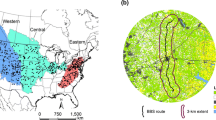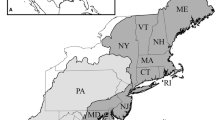Abstract
A simple regional habitat model founded on the relation between vertical habitat complexity and species richness has been used to describe wildlife habitat in response to macroscale patterns in land use and land cover. While the model has a basis in ecological theory, it has not been subjected to rigorous testing. We evaluated the model's fundamental assumption on landscapes in the eastern forested region of the United States and found the model to be supported when we used a measure of avian community integrity during the breeding season. The model was improved by incorporating measures of horizontal heterogeneity, indicating that the vertical and horizontal structure of habitats should be considered in analyzing the response of wildlife to land resource policies that can affect broad land use patterns.
Similar content being viewed by others
References
American Ornithologists' Union. 1983. Check-list of North American birds, 6th edition. American Ornithologists' Union. Allen Press, Lawrence, Kansas.
Askins, R.A. and Philbrick, M.J. 1987. Effect of changes in regional forest abundance on the decline and recovery of a forest bird community. Wilson Bull. 99: 7–21.
Atchley, W.R., Gaskins, C.I. and Anderson, D. 1976. Statistical properties of ratios. L Empirical results. Sysl. Zool. 25: 137–148.
August, P.V. 1983. The role of habitat complevity and heterogeneity in structuring tropical mammal communities. Ecology 64: 1495–1507.
Brown, J.H. and Roughgarden, J. 1990. Ecology for a changing earth. Ecol. Soc. Bull. 71: 173–188.
Bystrak, D. 1981. The North American breeding bird survey.In Estimating numbers of terrestrial birds. pp. 522–532. Edited by C.J. Ralph and J.M. Scott. Studies in Avian Biology No. 6.
Connell, J.H. 1978. Diversity in tropical rainforests and coral reefs. Science 199: 1302–1310.
DeGraat, R.M. 1986. Urban bird habitat relationships: application to landscape design. Trans. North Am. Wildl. Nat. Resour. Cont. 51: 232–248.
Devall, B. and Sessions, G. 1984. The development of natural resources and the integrity of nature. Environ. Ethies 6: 293–322.
Droege, S. 1990. The North American breeding bird survey. U.S. Department of the Interior. Eish and Wildlife Service. Biol. Rep. 90(1) Washington D.C.
Efron, B. 1982. The jackknife, the bootstrap and other resampling plans. SIAM. monograph #38. CBMS-NES. Regional conference series in applied mathematics.
Emlen, J.M. and Pikitch, E.K. 1989. Animal population dynamics: identification of critical components. Ecol. Model. 44: 253–273.
Eager, E.W. 1972. Diversity: a sampling study. Am. Nat. 106: 293–310.
Hather, C.H. and Hoekstra, I.W. 1989. An analysis of the wildlife and fish situation in the United States: 1989–2040. Gen. Lech. Rep. RM-178. U.S. Department of Agriculture, Forest Service, Rocky Mountain Forest and Range Expenment Station, Fort Collins, Colorado.
Flather, C.H. 1988. Wildlife abundance and occurrence models: application in regional resource planning.In Perspectives on land modelling. pp. 37–48. Edited by R. Gelinas, D. Bond. and B. Smit. Polyscience Publications, Montreal.
Forman, R. L. L. and Godron, M. 1981. Patches and structural components for a landscape ecology. BioScience 31: 733–740.
Forman, R. L. L. and Godron, M. 1986. Landscape ecology. John Wiley & Sons, Inc., New York.
Fuentes, E.R. 1988. The hump-backed species diversity curve: why has it not been found among land animals. Oikos 53: 139–143.
Gerell, R. 1988. Faunal diversity and vegetation structure of some deciduous forests in South Sweden. Holare. Ecol. 11: 87–95.
Helle, P. 1986. Bird community dynamics in a boreal forest reserve: the importance of large-scale regional trends. Ann. Zool. Fenn. 23: 157–166.
Hirsch, A., Krohn, W.B., Schweitzer, D.L., and Thomas, C.H. 1979. Irends and needs in federal inventories of wildlife habitat. Irans. North Am. Wildl. Nat. Resour. Conf. 44: 340–359.
Hunter, M.L. 1987. Managing forests for spatial heterogeneity to maintain biological diversity. Trans. North Am. Wildl. Nat. Resour. Conf. 52: 60–69.
Inkley, D.B. 1985. Relationships between avian species richness and environmental characteristics in North America. Thesis. Ph.D. University of Wyoming, Laramie.
Istock, C.A. and Scheiner, S.M. 1987. Affinities and higher-order diversity within landscape mosaics. Evol. Ecol. 1: 11–29.
Jackson, D.A., Harvey, H.H. and Somers, K.M. 1990. Ratios in aquatic sciences: statistical shortcomings with mean depth and the morphoedaphic indev. Can. J. Fish. Aquat. Sci. 47: 1788–1795.
James, E.C. and Rathbun, S. 1981. Rarefaction, relative abundance, and diversity of avian communities. Auk 98: 785–800.
Karr, J.R. 1990. Biological integrity and the goal of environmental legislation: lessons for conservation biology. Conserv. Biol. 4: 244–250.
Karr, J.R. and Dudley, D.R. 1981. Ecological perspective on water quality goals. Environ. Manage. 5: 55–68.
Karr, J.R. and Roth, R.R. 1971. Vegetation structure and avian diversity in several new world areas. Am. Nat. 105: 423–435.
Kenny, B.C. 1982. Beware of spurious self-correlations. Water Resour. Res. 18: 1041–1048.
Kleinbaum, D.G., Kupper, L. L. and Muller, K.E. 1988. Applied regression analysis and other multivariable methods. PWS-Kent Publishing Co., Boston, Massachusetts.
Klopatek, J.M. and Kitchings, J.I. 1985. A regional technique to address land-use changes and animal habitats. Environ. Conserv. 12: 343–350.
Klopatek, J.M., Krummel, J.R., Mankin, J.B. and O'Neill, R.V. 1983. A theoretical approach to regional environmental conflicts. J. Environ. Manage. 16: 1–15.
Klopatek, J.M., Olson, R.J., Emerson, C.J. and Joness, J.I. 1979. Land-use conflicts with natural vegetation in the United States. Environ. Conserv. 6: 191–199.
Knight, D.H. 1987. Parasites, lightning, and the vegetation mosate in wilderness landscapes.In Landscape heterogeneity and disturbance. pp. 59–83. Edited by M.G. Lurner. Springer-Verlag, New York.
Kotliar, N.B. and Wiens, J.A. 1990. Multiple scales of patchiness and patch structure: a bierarchical framework for the study of heterogencity. Oikos 59: 253–260.
Krummel, J.R., Gardner, R.H., Sugihara, G., O'Neill, R.V. and Coleman, P.R. 1987. Landscape pattern in a disturbed environment. Oikos 48: 321–324.
Kuchler, A.W. 1964. Potential natural vegetation on the conterminous United States. Am. Geogr. Soc. Spec. Publ. 36.
Lennartz, M.R. and McClure, J.P. 1979. Estimating the extent of red-cockaded woodpecker habitat in the southeast.In Forest resource inventories, vol. 1, pp. 48–62. Edited by W.E. Erayer. Colorado State University, Fort Collins, Colorado.
MacArthur, R.H. and MacArthur, J.W. 1961. On bird species diversity. Ecology 42: 594–598.
MacArthur, R.H., MacArthur, J.W. and Preer, J. 1962. On bird species diversity II. Prediction of bird censits from habitat measurements. Am. Nat. 96: 167–174.
MacNally, R.C. 1990a. An analysis of density responses of forest and woodland birds to composite physiognomic variables. Aust. J. Ecol. 15: 267–275.
MacNally, R.C. 1990b. The roles of floristies and physiognomy in avian community composition. Aust. J. Ecol. 15: 321–327.
Maurer, B.A. 1985. Avian community dynamics in desert grasslands: observational scale and hierarchial structure. Ecol. Monogr. 55: 295–312.
Milne, B.T. 1991. Lessons from applying fractal models to landscape patterns.In Quantitative methods in landscape ecology. pp. 199–235. Edited by M.G. Lurner and R.H. Gardner. Springer Verlag, New York.
Noon, B.R., Dawson, D.K. and Kelly, J.P. 1985. A search for stability gradients in North American breeding bird communities. Auk 102: 64–81.
Noss, R. and Harris, L. 1986. Nodes, networks, and MUM's: preserving diversity at all scales. Environ. Manage. 10: 299–309.
O'Neill, R.V., Krummel, J.R., Gardner, R.H., Sugihara, G., Jackson, B., DeAngelis, D.L., Milne, B.L., Turner, M.G., Zygmunt, B., Christensen, S.W., Dale, V.H. and Graham, R.L. 1988. Indices of landscape pattern. Landse. Ecol. 1: 153–162.
Owen, J.G. 1990. An analysis of the spatial structure of mammalian distribution patterns in Tevas. Ecology 71: 1823–1832.
Pickett, S.I.A. 1976. Succession: an evolutionary interpretation. Am. Nat. 110: 107–119.
Recher, H.E. 1969. Bird species diversity and habitat diversity in Australia and North America. Am. Nat. 103: 75–80.
Ricklefs, R.E. 1987. Community diversity: relative roles of local and regional processes. Science 235: 167–171.
Rotenberry, J.T. 1985. The role of habitat in avian community composition: physiognomy or floristies? Oecologia 67: 213–217.
Roth, R.R. 1976. Spatial heterogeneity and bird species diversity. Ecology 57: 773–782.
Salazar, D.J. and Lee, R.G. 1990. Natural resource policy analysis and rational choice theory: a strategy for empirical research. Nat. Resour. J. 30: 283–300.
Sanders, H.L. 1968. Marine benthic diversity: a comparative study. Am. Nat. 102: 243–282.
Sanderson, G.C. Ables, E.D., Sparrowe, R.D., Grieb, J.R., Harris, L.D. and Moen, A.N. 1979. Research needs in wildlife. Itans. North Am. Wildl. Nat. Resour. Conf. 44: 166–175.
Schroeder, R.L. 1987. Community models for wildlife impact assessment: a review of concepts and approaches. Biological Report 87(2). U.S. Department of the Interior, Fish and Wildlife Service.
Sheffield, R.M. 1981. Multiresource inventories: techniques for evaluating nongame bird habitat. Res. Pap. SE-218. U.S. Department of Agriculture, Forest Service, Southeastern Forest Experiment Station, Asheville, North Carolina.
Short, H.L. 1982. Development and use of a habitat gradrent model to evaluate wildlife habitat. Trans. North Am. Wildl. Nat. Resour. Conf. 47: 57–72.
Short, H.L. 1988. A habitat structure model for natural resource management. J. Environ. Manage. 27: 289–305.
Short, H.L. and Burnham, K.P. 1982. Technique for structuring wildlife guilds to evaluate impacts on wildlife communities. USDI, Fish and Wildlife Service. Spec. Sci. Rep. Wildl. No. 244. Washington, D.C.
Streeter, R.G., Chalk, D.F., Thomas, C.H. and Krohn, W.B. 1983. National appraisal for wildlife habitat from inventory to management.In Renewable resource inventories for monitoring changes and trends. pp. 674–677. Edited by J.E. Bell and I. Atterbury. Oregon State University, Corvallis, Oregon.
Swanson, F.J., Kratz, T.K., Caine, N. and Woodmansee, R.G. 1988. Landform effects on ecosystem pattern and process. BioScience 38: 92–98.
Swanson, E.J. and Sparks, R.E. 1990. Long-term ecological research and the invisible place. BioScience 40: 502–508.
Szaro, R.C. 1987. Guild management: an evaluation of avian guilds as a predictive tool. Environ. Manage. 10: 681–688.
Lurnet, M.G., (ed.) 1987. Landscape heterogeneity and disturbance. Springer-Verlag, New York.
Urban, D.L., O'Neill, R.V. and Shugart, H.H. 1987. Landscape ecology: a hierarchial perspective can help scientists understand spatial patterns. BioScience 37: 119–127.
U.S. Department of Agriculture 1989a. A national program for soil and water conservation. U.S. Government Printing Office, Washington, D.C.
U.S. Department of Agriculture, 1989b. The second RCA appraisal. U.S. Government Printing Office, Washington, D.C.
U.S. Department of Agriculture, Soil Conservation Service. 1981. I and resource regions and major land resource areas of the United States. Agriculture Handbook 296. Washington, D.C.
U.S. Department of Agriculture, Soil Conservation Service. 1987. Basic statistics. 1982 national resources inventory. Statistical Bulletin 756. U.S. Department of Agriculture, Soil Conservation Service, Washington, D.C.
U.S. Department of the Interior, Geological Survey. 1987. I and use and land cover digital data from 1:250,000- and 1:100,000-scale maps. Data users guide 4. U.S. Government Printing Office, Washington, D.C.
Verner, J. 1984. The guild concept applied to management of bird populations. Environ. Manage. 8: 1–14.
Walker, P.A. 1990. Modelling wildlife distributions using a geographic information system: kangaroos in relation to climate. J. Biogeogr. 17: 279–289.
Wiens, J.A. 1989. The ecology of bird communities. Volume I. Foundations and patterns. Cambridge University Press, Cambridge, England.
Wiens, J.A. 1991. Ecological similarity of shrub-desert avifauna of Australia and North America. Ecology 72: 479–495.
Wiens, J.A., Rotenberry, J.L. and Van Horne, B. 1987. Habitat occupancy patterns of North American shrub-steppe birds: the effects of spatial scale. Oikos 48: 132–147.
Wilson, M.V. and Shmida, A. 1984. Measuring beta diversity with presence-absence data. J. Ecol. 72: 1055–1064.
Author information
Authors and Affiliations
Additional information
In cooperation with Colorado State University.
Rights and permissions
About this article
Cite this article
Flather, C.H., Brady, S.J. & Inkley, D.B. Regional habitat appraisals of wildlife communities: a landscape-level evaluation of a resource planning model using avian distribution data. Landscape Ecol 7, 137–147 (1992). https://doi.org/10.1007/BF02418944
Issue Date:
DOI: https://doi.org/10.1007/BF02418944




